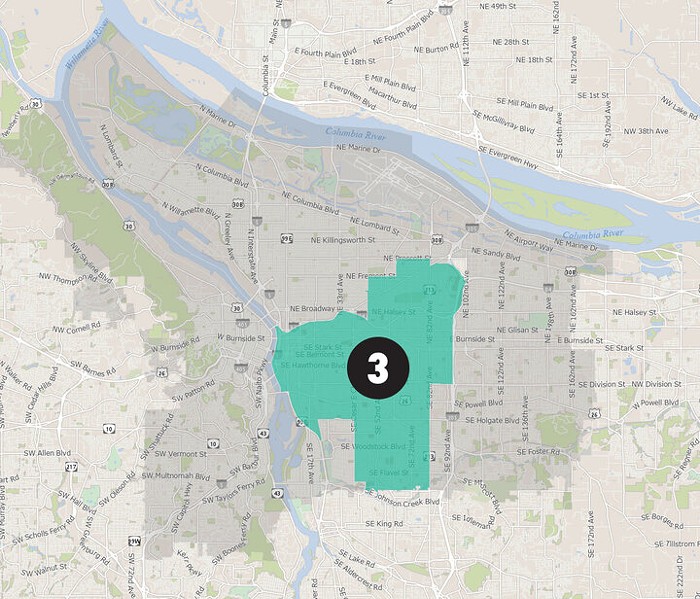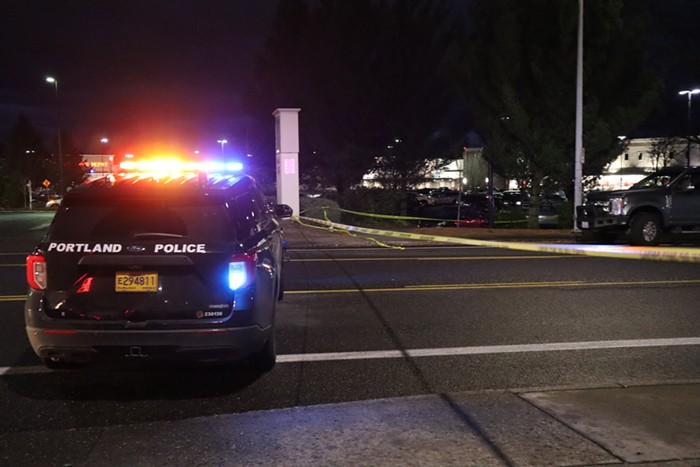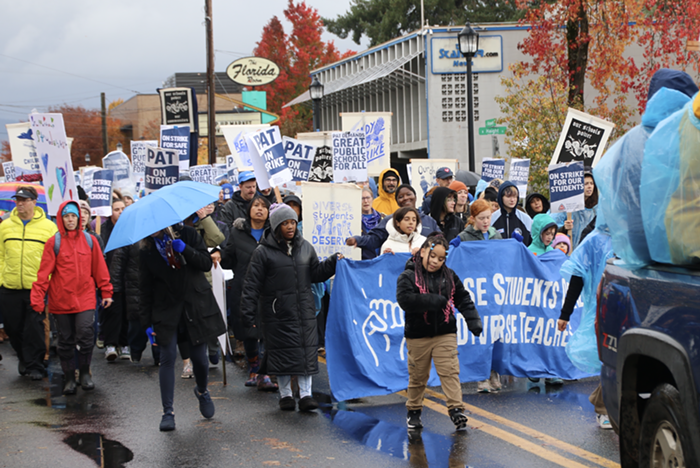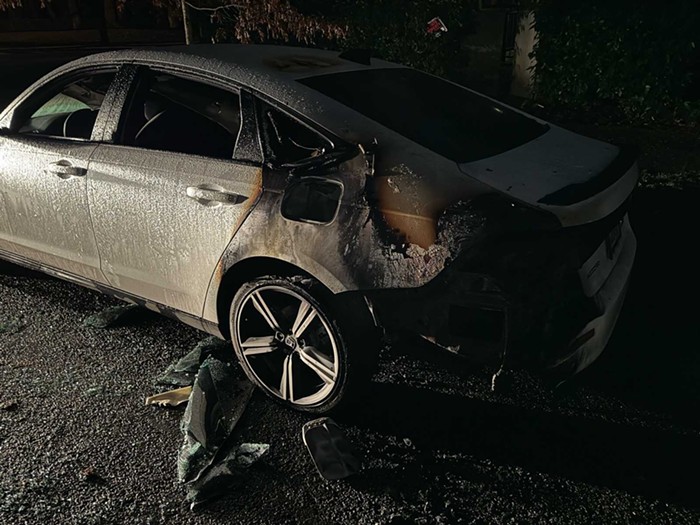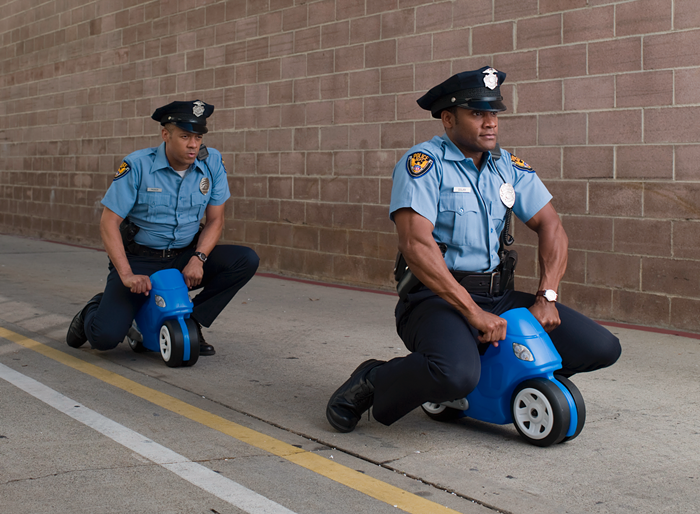For the past month, a small, air-conditioned bus has spent weekdays migrating slowly up and down Southeast Water Avenue, offering free rides to oblivious customers. Since its July 9 start date, drivers pick up an average of one passenger during each of their two three-hour shifts—one during the morning commute, the other during evening rush hour. According to one driver, there have been several days in a row where the bus hasn’t had a single rider.
The publicly funded Water Ave Courtesy Shuttle doesn’t look like a free bus. Many on the Central Eastside assume it’s private shuttle for either a wedding party or a business association. And they’re not entirely wrong.
The shuttle was proposed by the Central Eastside Industrial Council (CEIC), a nonprofit chaired by a group of business owners, neighborhood association presidents, and developers who, among other things, recommend transportation programs to the city. The CEIC hopes the shuttle will cut down on vehicle emissions, discourage visitors from parking cars in their rapidly growing business district, and help people feel “safe” in a neighborhood that’s home to a number of small homeless encampments.
“Who is the audience for this shuttle, and what is the problem the shuttle is trying to solve?”
But by using a private shuttle company that owns most of the parking lots near the shuttle stops, and by creating a route that passes property and businesses owned by CEIC board members, the shuttle may be as much a Central Eastside business investment as it is a solution to transportation issues.
A subsection of CEIC members have worked to improve parking issues in the Central Eastside since 2012, after neighbors pointed out a trend of commuters parking on the Eastside, then walking or busing to work downtown. Dubbed the Transportation and Parking Advisory Committee (TPAC), the group is responsible for suggesting new solutions to the area’s parking programs to the Portland Bureau of Transportation (PBOT), who sends a final request to Portland City Council. These solutions—like the shuttle—are funded by a fee tacked onto the cost of a monthly permit to park in the Central Eastside. Currently, an annual parking permit costs $300, and a whopping $240 of that goes to TPAC projects.
“The price both discourages people from getting a permit and provides a fund for us to do some things,” says Susan Pearce, former chair of the Hosford-Abernethy Neighborhood District association and TPAC committee member.
That funding often goes toward improved street signs, discounted transit passes for employees of neighborhood businesses, bike racks, new crosswalks, and sidewalk cleanups—anything that TPAC deems will improve public transportation and discourage driving. In the 2018-2019 budget, TPAC flagged $250,000 of its estimated $1,744,000 budget to fund a year-long shuttle program meant to address issues raised in a recent survey of neighborhood employees, customers, business owners, and residents.
“People were concerned about walking in the dark and dreary hours,” says Pearce. “It’s an edgy part of town.”
According to TriMet spokesperson Roberta Altstadt, TriMet used to run a bus line along the shuttle route, but it was cancelled due to low ridership numbers.
“Since Line 6 and Portland Streetcar are a short distance from Water Avenue, we are not currently considering routing buses on Water Avenue,” says Altstadt.
Kate Merrill, executive director of CEIC, says the nonprofit will assess the shuttle’s success before the year-long pilot program comes to an end next July. The CEIC hopes the data it collects will convince TriMet to consider restarting that retired route.
The shuttle is currently run by City Center Parking, a longtime Portland company that runs dozens of pay-to-park lots across town. The shuttle’s six stops are spread out along a north-south route, which runs from the Oregon Convention Center to Southeast Powell. Each stop is located by a parking lot—suggesting that passengers will still be driving and parking in the neighborhood before boarding the shuttle. The shuttle stops do not directly align with any of the nearby public transportation routes—instead, three of its six stops are either inside or next to parking lots run by City Center Parking, meaning the company’s essentially being paid to shuttle its own customers to their cars.
Two other lots are on property owned by CEIC board members.“It ultimately makes their parking lots more convenient for people,” says Tony Jordan, founder of Portlanders for Parking Reform. “It’s an interesting visual.”
The only shuttle stop not adjacent to a City Center lot is located in the parking lot of the Eastside Exchange Building—a building owned by Beam Development, a company run by CEIC Board President Brad Malsin. The lot is across the street from the Slate apartment building, another major Beam project.
Pearce says the shuttle will ideally connect with a parking structure that CEIC wants to see built in the Central Eastside. While the city has historically discouraged the construction of major parking structures, PBOT staff say the idea isn’t entirely off the table.
“We will have to a hire a consultant to look at the possibility,” says Chris Armes, who manages PBOT’s parking programs. In their last budget, TPAC put around $125,000 toward funding a study of structured parking.
This focus on expanding parking gives transportation advocates like Jordan pause, especially since one of TPAC’s ostensible goals is to disincentivize car use.
“We should be spending money on improvements that will encourage people not to drive,” says Jordan. “Instead of buying a shuttle or saving money for a parking structure in the future, we could be giving people bus passes right now. Seems to do a lot more good if you’re really trying to improve transportation in the area.”
TPAC is putting a portion of its annual funds toward other, non-shuttle programs, like offering major discounts for annual streetcar passes, Biketown memberships, and a TriMet Hop pass with $100 credit to people who work in the neighborhood.
The shuttle’s longevity ultimately comes down to CEIC answering two simple questions posed by Jordan: “Who is the audience for this shuttle, and what is the problem the shuttle is trying to solve?”

